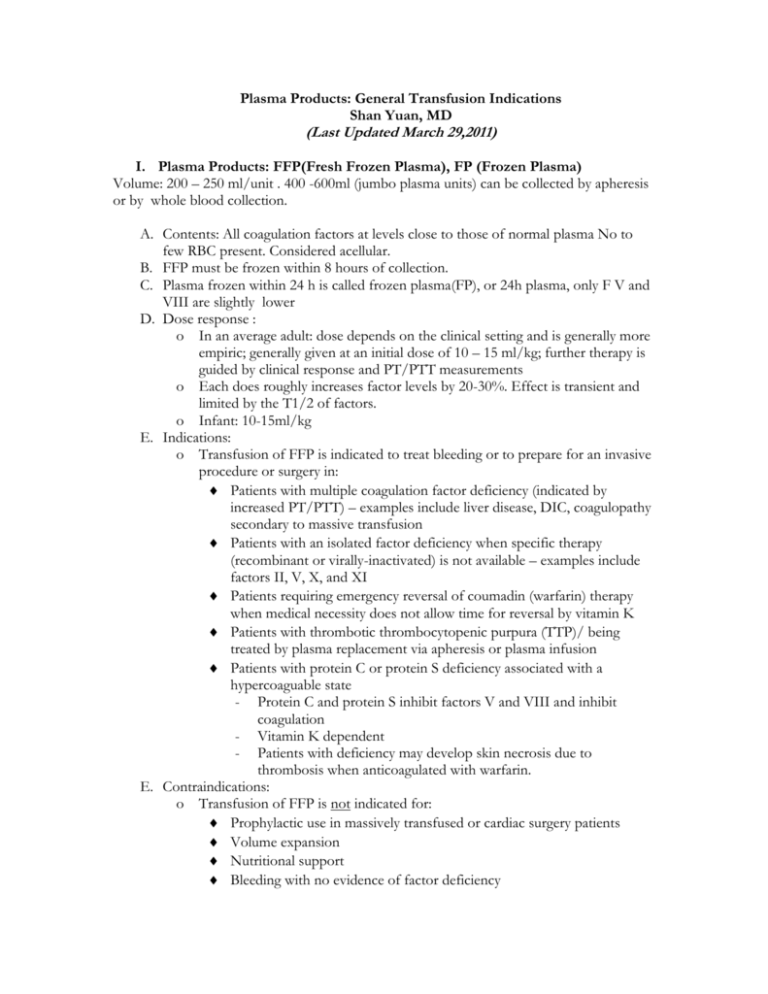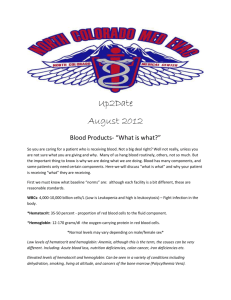Indications for Plasma Products and Cryoprecipitate
advertisement

Plasma Products: General Transfusion Indications Shan Yuan, MD (Last Updated March 29,2011) I. Plasma Products: FFP(Fresh Frozen Plasma), FP (Frozen Plasma) Volume: 200 – 250 ml/unit . 400 -600ml (jumbo plasma units) can be collected by apheresis or by whole blood collection. A. Contents: All coagulation factors at levels close to those of normal plasma No to few RBC present. Considered acellular. B. FFP must be frozen within 8 hours of collection. C. Plasma frozen within 24 h is called frozen plasma(FP), or 24h plasma, only F V and VIII are slightly lower D. Dose response : o In an average adult: dose depends on the clinical setting and is generally more empiric; generally given at an initial dose of 10 – 15 ml/kg; further therapy is guided by clinical response and PT/PTT measurements o Each does roughly increases factor levels by 20-30%. Effect is transient and limited by the T1/2 of factors. o Infant: 10-15ml/kg E. Indications: o Transfusion of FFP is indicated to treat bleeding or to prepare for an invasive procedure or surgery in: Patients with multiple coagulation factor deficiency (indicated by increased PT/PTT) – examples include liver disease, DIC, coagulopathy secondary to massive transfusion Patients with an isolated factor deficiency when specific therapy (recombinant or virally-inactivated) is not available – examples include factors II, V, X, and XI Patients requiring emergency reversal of coumadin (warfarin) therapy when medical necessity does not allow time for reversal by vitamin K Patients with thrombotic thrombocytopenic purpura (TTP)/ being treated by plasma replacement via apheresis or plasma infusion Patients with protein C or protein S deficiency associated with a hypercoaguable state - Protein C and protein S inhibit factors V and VIII and inhibit coagulation - Vitamin K dependent - Patients with deficiency may develop skin necrosis due to thrombosis when anticoagulated with warfarin. E. Contraindications: o Transfusion of FFP is not indicated for: Prophylactic use in massively transfused or cardiac surgery patients Volume expansion Nutritional support Bleeding with no evidence of factor deficiency Mild prolongation of PT/INR or a PTT Heparin reversal F. ABO compatibility: FFP has ABO antibodies, so must be ABO compatible, see chart below. G. Rh compatibility: Not an issue. Plasma products have no RBCS H. Other plasma products: o SD-Plasma Pooled product from 2500 ABO identical donors Standard volume of 200 ml Treated with solvent and detergent, then ultrafiltration to remove HMW vW F SD treatments eliminates lipid-coated viruses-HIV, HCV, HBV, but not non enveloped viruses such as parvovirus B19, HAV Deficient in some factors: FVIII, vWF, Protein S Reported association with thrombotic events in liver transplant patients, possibly due to Protein S deficiency? o Cryo-poor plasma Supernatant recovered after cryoprecipitate made, deficient in all “cryo factors”: VIII, XIII, vWF, fibrinogen, fibronectin Only indications: Plasma exchange for relapsing TTP or TTP responsive to exchange with FFP. However has not been shown to be superior than FFP as initial therapy. o Donor-retested plasma Objective is to reduce window period donations of FFP FFP is held for 112 days, then donor retested FFP put into inventrory if retesting results negative Little use due to complexity, loss of unit if donor does not return, storage cost. Superseded by NAT. o Thawed plasma Prepared from FFP or FP (plasma frozen within 24hours) Shelf life of 5 days after thawing. Some loss of FVIII and FV, okay for most patients and clinical settings. Major advantage is that it is already in ready-to-transfuse liquid form, time saved in thawing o Liquid plasma Prepared from WB, plasma separated and kept in liquid state Stored at 1-6C. Expires 5 days after the expiration date of the WB from which it was prepared. Need of thawing obviated o Recovered plasma An unlicensed product. Converted from plasma and liquid plasma Usually shipped to a manufacturer and fractionated into derivatives such as albumin and immune globulins. Has no expiration date. But records for this component must be retained indefinitely. Collecting facility must have a „short supply agreement‟ with the manufacturer. Cryoprecipitate A. Preparation: Thaw FFP at 1-6C, decant supernatant (which is cryo-poor plasma), refreeze cold insoluble proteins (10-20ml) B. Store at -18C for up to one year, thaw at 37C and store at 20-24C for up to 6 hours. before use. ( May be pooled after thawing, which shortens shelf life to 4 hours. C. Dose response to an average unit in an average adult: Each unit contains >150 mg of fibrinogen, > 80 IU of Factor VIII, 30 – 50 mg of fibronectin, 40 – 70% of whole blood vWF and 30% of whole blood Factor XIII. o For treatment of hypofibrinogenemia: 5 units is often used as initial therapy in adults with additional units administered as dictated by the patient‟s fibrinogen level. Each unit of cryoprecipitate will raise the recipient‟s circulating fibrinogen level by about 10 mg/dL o Availability of recombinant and heat-treated/solvent-detergent-treated products used preferentially to treat patients with Hemophilia A (supplied by the pharmacy). D. Indications: Hypofibrinogenia, increased risk of bleeding: - Patients with congenital hypofibrinogenemia (< 100 mg/dL) or dysfibrinogenemia - Patients with acquired hypofibrinogenemia, for example DIC (< 100 mg/dL) – most common clinical indication for cryoprecipitate Patients with severe vWD (only when factor concentrate/DDAVP is contraindicated, ineffective, or unavailable) Factor XIII deficiency (FXIII concentrate available in Europe, but not in the US) Topical “glue” – mixed with bovine/human thrombin, add Ca++ to create fibrin gel. This is being replaced by pathogen inactivated pooled cryoprecipitate – Tisseal TM . Uremic thrombocytopathy: Probable acquired adhesion defect, may respond to vWF supplementation. Second line therapy to DDAVP. Also should consider conjugated estrogens, and increasing hematocrit to about 30% E. Contraindications: o Cryoprecipitate should not be transfused to patients with deficiencies of factors other that fibrinogen, XIII, vWF and fibronectin. F. Dose calculations: o Example: 70 kg male with Hct of 40% and a fibrinogen of 50mg/dl; clinicians would like to raise his fibrinogen to 200 mg/dl. Start by calculating plasma volume (PV) - PV = (wt. in Kg) x (70 ml/kg) x (1 – Hct) - For the above patient: PV = 70 x 70 x .6 = 2940 ml plasma Next, determine total circulating fibrinogen - Total circulating fibrinogen = PV x (fibrinogen) (must convert plasma volume to dl) - For the above patient: 29.4 dl x 50 mg/dl = 1470 mg fibrinogen Next, determine the total desired fibrinogen (following transfusion) - Total desired fibrinogen = 29.4 dl x 200 mg/dl = 5880 mg Finally, determine the fibrinogen deficit and calculated bags required for transfusion - Fibrinogen deficit = (total desired) – (total circulating) - For this patient: 5880 mg – 1470 mg = 4410 mg - Since each bag of cryo contains approximately 200 mg fibrinogen, the above patient would need about 22 bags of cryo (4410 mg/ 200 mg fibrinogen per bag)








